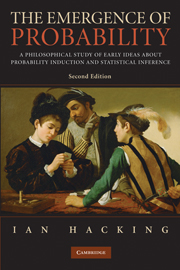 The Emergence of Probability
The Emergence of Probability Book contents
- Frontmatter
- Contents
- Introduction 2006
- 1 An absent family of ideas
- 2 Duality
- 3 Opinion
- 4 Evidence
- 5 Signs
- 6 The first calculations
- 7 The Roannez circle (1654)
- 8 The great decision (1658?)
- 9 The art of thinking (1662)
- 10 Probability and the law (1665)
- 11 Expectation (1657)
- 12 Political arithmetic (1662)
- 13 Annuities (1671)
- 14 Equipossibility (1678)
- 15 Inductive logic
- 16 The art of conjecturing (1692[?] published 1713)
- 17 The first limit theorem
- 18 Design
- 19 Induction (1737)
- Bibliography
- Index
9 - The art of thinking (1662)
Published online by Cambridge University Press: 05 April 2013
- Frontmatter
- Contents
- Introduction 2006
- 1 An absent family of ideas
- 2 Duality
- 3 Opinion
- 4 Evidence
- 5 Signs
- 6 The first calculations
- 7 The Roannez circle (1654)
- 8 The great decision (1658?)
- 9 The art of thinking (1662)
- 10 Probability and the law (1665)
- 11 Expectation (1657)
- 12 Political arithmetic (1662)
- 13 Annuities (1671)
- 14 Equipossibility (1678)
- 15 Inductive logic
- 16 The art of conjecturing (1692[?] published 1713)
- 17 The first limit theorem
- 18 Design
- 19 Induction (1737)
- Bibliography
- Index
Summary
Chances, odds, ‘hazards’ (the stock in trade of aleatory probability) are basically quantitative. There is no way to understand odds without understanding numerical ratios. Epistemic probability is not like this. You can compare the degree to which evidence warrants several propositions without recourse to numbers. Indeed Keynes argued masterfully in Chapter 3 of his Treatise on Probability that many comparisons of probability are necessarily qualitative and cannot be represented by real numbers. Subsequently B. O. Koopman [1940] elaborated the logic of qualitative probability. A new book by T. Fine [1973] advances this work several stages further. There is nothing logically defective in mere comparisons of probability. But as a matter of historical fact epistemic probability did not emerge as a significant concept for logic until people thought of measuring it. When did this begin?
It is convenient to answer by looking at the word ‘probability’ itself. We need not do this. We are concerned with the first occasion on which some probabilistic expression with epistemic overtones was systematically used to denote something measurable. We could survey the usage of ‘credibility’ or whatever, but in fact the word ‘probability’ itself is the one to watch for. So we ask the exact question: when was this word first used to denote something measurable?
The answer seems to be 1662, in the concluding pages of the Port Royal Logic. There could not have been a more auspicious beginning. La logique, ou l'art de penser was the most successful logic book of the time and cast the mould for generations of future treatises.
- Type
- Chapter
- Information
- The Emergence of ProbabilityA Philosophical Study of Early Ideas about Probability, Induction and Statistical Inference, pp. 73 - 84Publisher: Cambridge University PressPrint publication year: 2006
- 1
- Cited by
